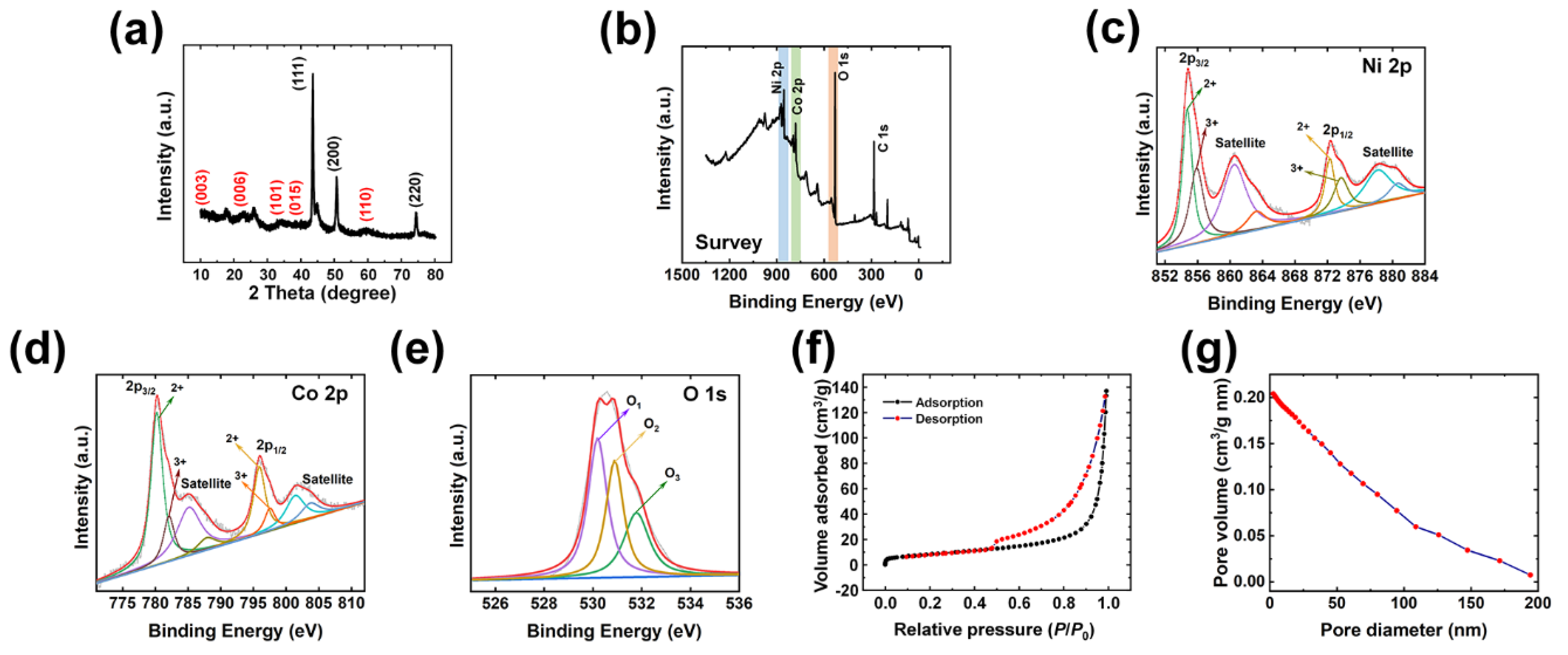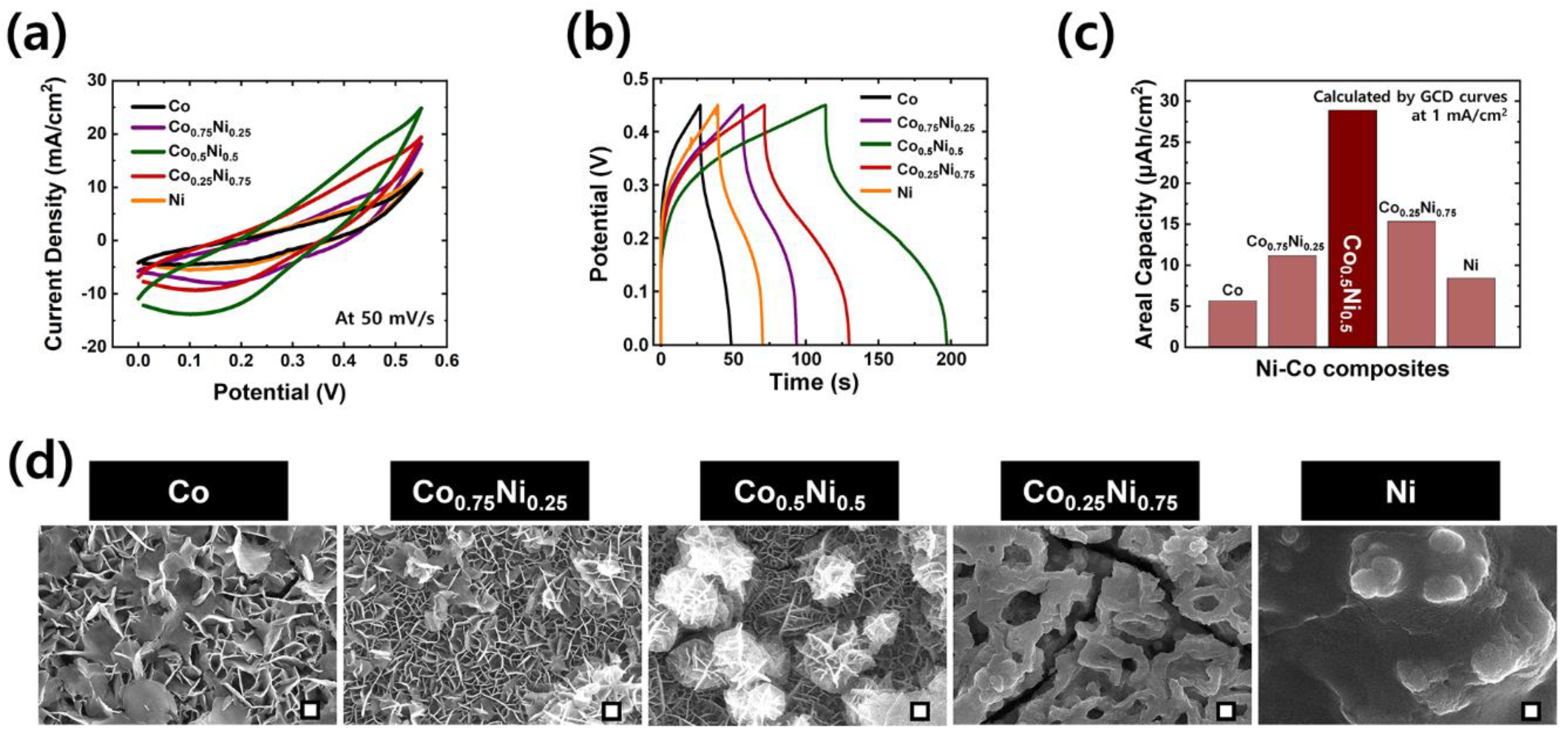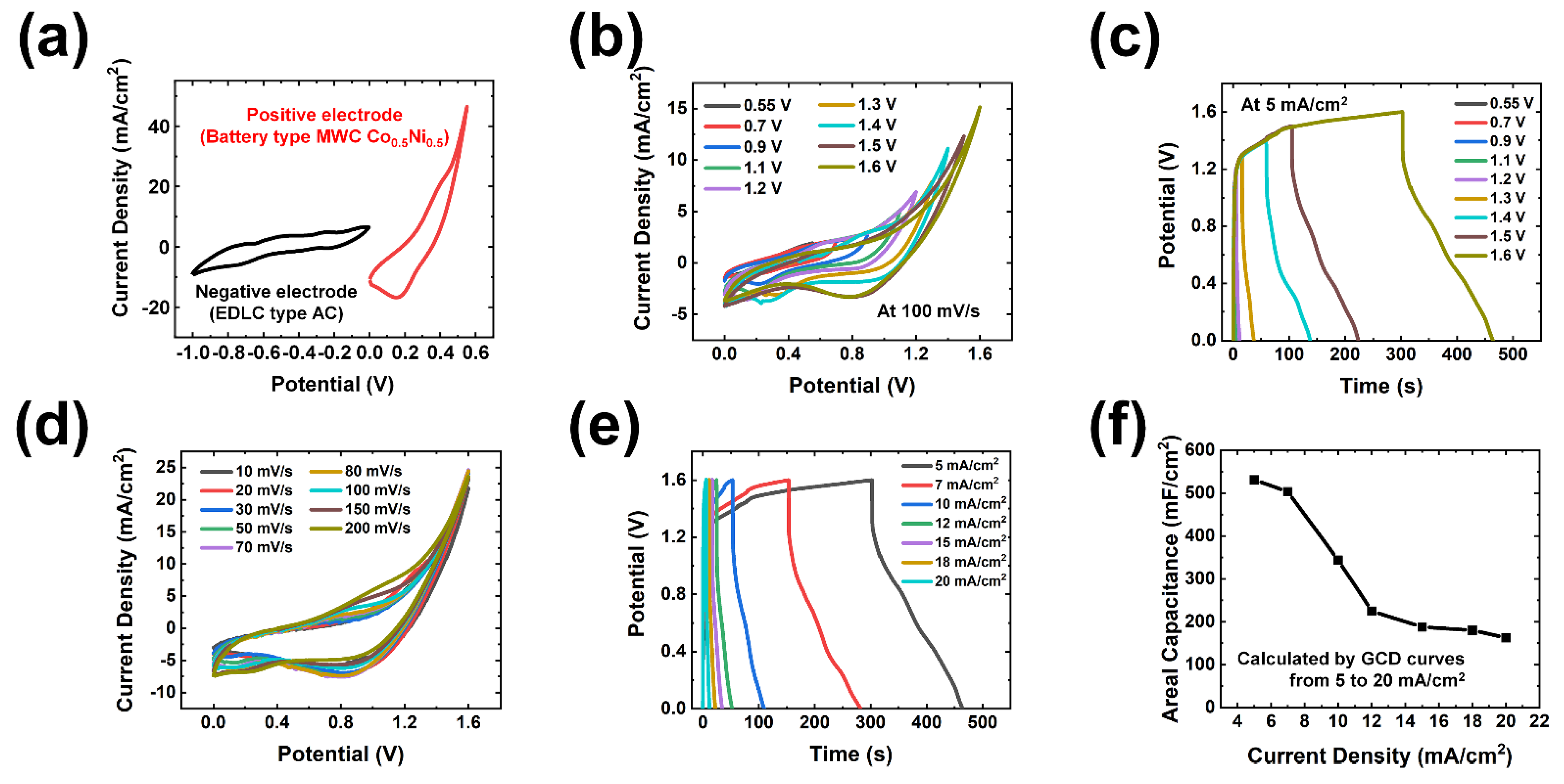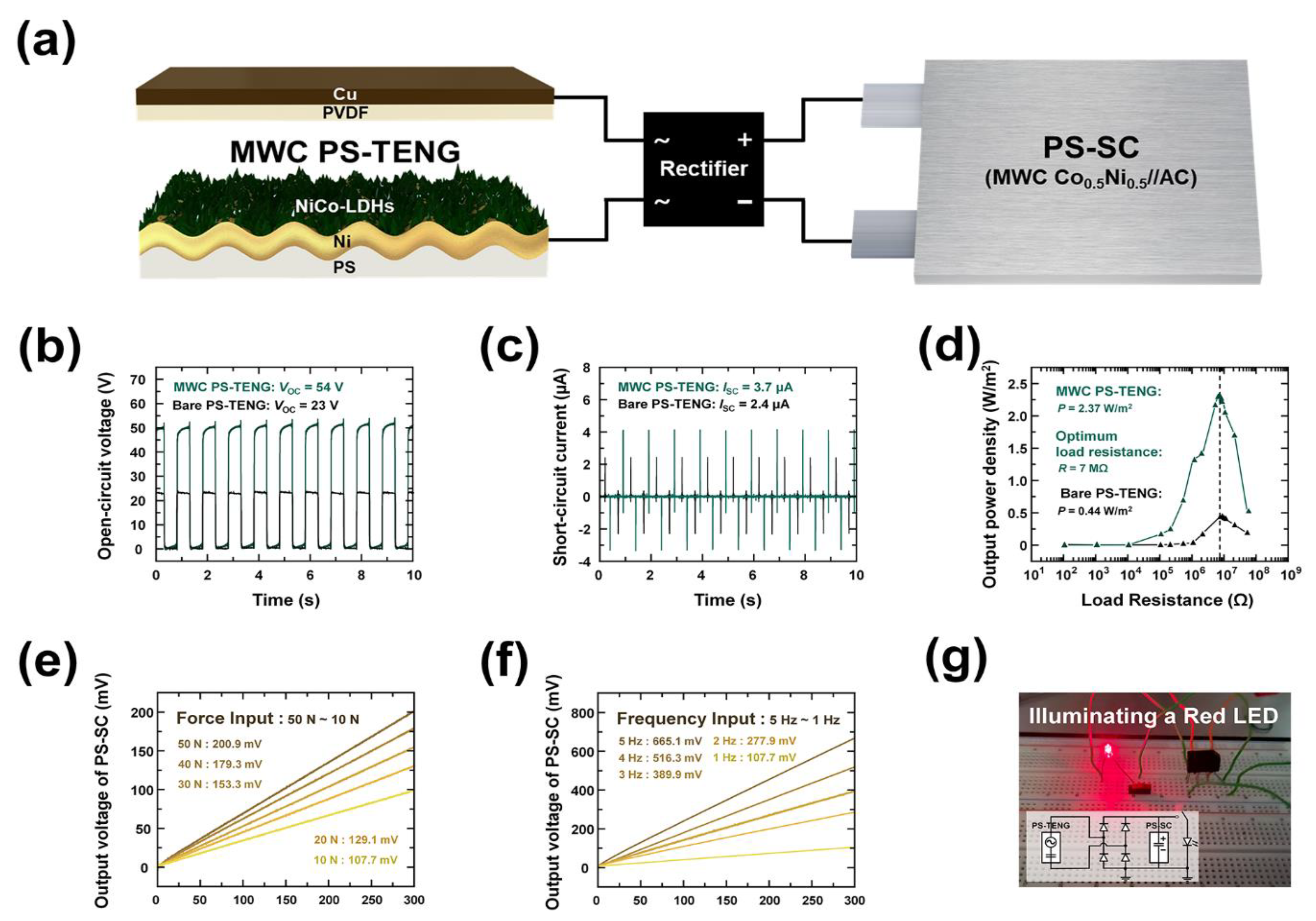Microwave-Assisted Hierarchically Grown Flake-like NiCo Layered Double Hydroxide Nanosheets on Transitioned Polystyrene towards Triboelectricity-Driven Self-Charging Hybrid Supercapacitors
Abstract
1. Introduction
2. Experimental Section
2.1. Materials
2.2. Deposition of Thin Ni Layer onto PS Substrate
2.3. Preparation of Ni-Co Layered Double Hydroxides (LDHs) on Conductive PS Layer
2.4. Preparation of Activated Carbon (AC)-Coated Negative Electrode
3. Physical Characterization
3.1. Electrochemical Characterization
3.2. Electrical Measurement
3.3. Fabrication of Pouch-Type HSC Device
3.4. Preparation of Electrospun PVdF Membrane
4. Results and Discussions
5. Conclusions
Supplementary Materials
Author Contributions
Funding
Institutional Review Board Statement
Informed Consent Statement
Data Availability Statement
Conflicts of Interest
References
- Kitchamsetti, N.; Kim, D. Facile synthesis of hierarchical core-shell heterostructured ZnO/SnO2@NiCo2O4 nanorod sheet arrays on carbon cloth for high performance quasi-solid-state asymmetric supercapacitors. J. Mater. Res. Technol. 2022, 21, 590–603. [Google Scholar] [CrossRef]
- Park, J.; Jo, S.; Kitchamsetti, N.; Zaman, S.; Kim, D. The development of NiCo2O4/PVP/PANI heterogeneous nanocomposites as an advanced battery-type electrode material for high-performing supercapacitor application. J. Alloys Compd. 2022, 926, 166815. [Google Scholar] [CrossRef]
- Huang, S.; Zhu, X.; Sarkar, S.; Zhao, Y. Challenges and opportunities for supercapacitors. APL Mater. 2019, 7, 100901. [Google Scholar] [CrossRef]
- Wang, X.; Qu, G.; Hao, S.; Zhao, G.; Zhang, X.; Ma, W.; Xu, X. Improvement of nickel-cobalt-based supercapacitors energy storage, performance by modification of elements. J. Colloid Interface Sci. 2021, 602, 712–720. [Google Scholar] [CrossRef] [PubMed]
- Ajuria, J.; Redondo, E.; Arnaiz, M.; Mysyk, R.; Rojo, T.; Goikolea, E. Lithium and sodium ion capacitors with high energy and. power densities based on carbons from recycled olive pits. J. Power Sources 2017, 359, 17–26. [Google Scholar] [CrossRef]
- Najib, S.; Erdem, E. Current progress achieved in novel materials for supercapacitor electrodes: Mini review. Nanoscale Adv. 2019, 1, 2817–2827. [Google Scholar] [CrossRef]
- Chaudoy, V.; Van, F.T.; Deschamps, M.; Ghamouss, F. Ionic liquids in a poly ethylene oxide cross-linked gel polymer as an. electrolyte for electrical double layer capacitor. J. Power Sources 2017, 342, 872–878. [Google Scholar] [CrossRef]
- Faisal, M.; Abedin, F.; Asmatulu, R. Activated carbons of pistachio and acorn shells for supercapacitor electrodes with. TEABF4/PC solutions as electrolytes. Carbon Lett. 2020, 30, 509–520. [Google Scholar] [CrossRef]
- Kitchamsetti, N.; Chikate, P.R.; Patil, R.A.; Ma, Y.R.; Shirage, P.M.; Devan, R.S. Perforated mesoporous NiO nanostructures. for an enhanced pseudocapacitive performance with ultra-high rate capability and high energy density. Cryst. Eng. Comm. 2019, 21, 7130–7140. [Google Scholar] [CrossRef]
- Kitchamsetti, N.; Choudhary, R.; Phase, D.; Devan, R. Structural correlation of a nanoparticle-embedded mesoporous CoTiO3 perovskite for an efficient electrochemical supercapacitor. RSC Adv. 2020, 10, 23446–23456. [Google Scholar] [CrossRef]
- Nam, I.; Kim, N.; Kim, G.; Park, J.; Yi, J. Amorphous Mn oxide-ordered mesoporous carbon hybrids as a high performance electrode material for supercapacitors. J. Nanosci. Nanotechnol. 2012, 12, 5704–5708. [Google Scholar] [CrossRef] [PubMed]
- Kitchamsetti, N.; Ma, Y.; Shirage, P.; Deavn, R. Mesoporous perovskite of interlocked nickel titanate nanoparticles for efficient electrochemical supercapacitor electrode. J. Alloys Compd. 2020, 833, 155134. [Google Scholar] [CrossRef]
- Krishnan, S.; Rahim, M.; Jose, R. Synthesis and characterization of MnCo2O4 cuboidal microcrystals as a high performance psuedocapacitor electrode. J. Alloys Compd. 2016, 656, 707–713. [Google Scholar] [CrossRef]
- Sheng, S.; Liu, W.; Zhu, K.; Cheng, K.; Ye, K.; Wang, G.; Cao, D.; Yan, J. Fe3O4 nanospheres in situ decorated graphene as high-performance anode for asymmetric supercapacitor with impressive energy density. J. Colloid Interface Sci. 2019, 536, 235–244. [Google Scholar] [CrossRef] [PubMed]
- Sandhiya, M.; Vivekanand; Balaji, S.; Sathish, M. Na2MoO4-incorporated polymer gel electrolyte for high energy density flexible supercapacitor. ACS Appl. Energy Mater. 2020, 3, 11368–11377. [Google Scholar] [CrossRef]
- He, L.; Liu, Y.; Li, C.; Yang, D.; Wang, W.; Yan, W.; Zhou, W.; Wu, Z.; Wang, L.; Huang, Q.; et al. Low-Cost Zn-Based Aqueous Supercapacitor with High Energy Density. ACS Appl. Energy Mater. 2019, 2, 5835–5842. [Google Scholar] [CrossRef]
- Kumar, S.; Saeed, G.; Zhu, L.; Hui, K.; Kim, N.; Lee, J. 0D to 3D carbon-based networks combined with pseudocapacitive electrode material for high energy density supercapacitor: A review. Chem. Eng. J. 2021, 403, 126352. [Google Scholar] [CrossRef]
- Kitchamsetti, N.; Narsimulu, D.; Chinthakuntla, A.; Chakra, C.S. Bimetallic MOF derived ZnCo2O4 nanocages as a novel class of high performance photocatalyst for the removal of organic pollutants. Inorg. Chem. Commun. 2022, 144, 109946. [Google Scholar] [CrossRef]
- Wu, S.; Chen, Y.; Jiao, T.; Zhou, J.; Cheng, J.; Liu, B.; Yang, S.; Zhang, K.; Zhang, W. An Aqueous Zn-Ion Hybrid Supercapacitor with High Energy Density and Ultrastability up to 80000 Cycles. Adv. Energy Mater. 2019, 9, 1902915. [Google Scholar] [CrossRef]
- Rani, J.R.; Thangavel, R.; Oh, S.I.; Lee, Y.S.; Jang, J.H. An ultra-high-energy density supercapacitor; fabrication based on thiol-functionalized graphene oxide scrolls. Nanomaterials 2019, 9, 148. [Google Scholar] [CrossRef]
- Nguyen, V.T.; Ting, J.M. A Redox-Additive Electrolyte and Nanostructured Electrode for Enhanced Supercapacitor Energy Density, ACS Sustain. Chem. Eng. 2020, 8, 18023–18033. [Google Scholar] [CrossRef]
- Redondo, E.; Fevre, L.W.L.; Fields, R.; Todd, R.; Forsyth, A.J.; Dryfe, R.A.W. Enhancing supercapacitor energy density by mass-balancing of graphene composite electrodes. Electrochim. Acta 2020, 360, 136957. [Google Scholar] [CrossRef]
- Dai, S.; Bai, Y.; Shen, W.; Zhang, S.; Hu, H.; Fu, J.; Wang, X.; Hu, C.; Liu, M. Core-shell structured Fe2O3@Fe3C@C nanochains and Ni–Co carbonate hydroxide hybridized microspheres for high-performance battery-type supercapacitor. J. Power Sources 2021, 482, 228915. [Google Scholar] [CrossRef]
- Jiang, W.; Hu, F.; Yan, Q.; Wu, X. Investigation on electrochemical behaviors of NiCo2O4 battery-type supercapacitor electrodes: The role of an aqueous electrolyte. Inorg. Chem. Front. 2017, 4, 1642–1648. [Google Scholar] [CrossRef]
- Pawar, S.A.; Patil, D.S.; Shin, J.C.; Kim, H.J. Enhanced battery-type supercapacitor performance based on composite structure of nickel cobaltite and cadmium sulfide. J. Electroanal. Chem. 2020, 873, 114370. [Google Scholar] [CrossRef]
- Park, S.; Shinde, N.M.; Shinde, P.V.; Lee, D.; Yun, J.M.; Kim, K.H. Chemically grown bismuth-oxy-iodide (BiOI/Bi9I2) nanostructure for high performance battery-type supercapacitor electrodes. Dalton Trans. 2020, 49, 774–780. [Google Scholar] [CrossRef]
- Yu, D.; Zheng, X.; Chen, M.; Dong, X. Large-scale synthesis of Ni(OH)2/peach gum derived carbon nanosheet composites with high energy and power density for battery-type supercapacitor. J. Colloid Interface Sci. 2019, 557, 608–616. [Google Scholar] [CrossRef]
- Ma, Z.; Sun, Z.; Qu, F. High-performance battery-type Fe1-xS@CFs anode for all-solid-state battery-type asymmetric supercapacitor with high energy density and wide working temperature range. Appl. Surf. Sci. 2021, 537, 147817. [Google Scholar] [CrossRef]
- Zhang, D.; Guo, X.; Tong, X.; Chen, Y.; Duan, M.; Shi, J.; Jiang, C.; Hu, L.; Kong, Q.; Zhang, J. High-performance battery-type supercapacitor based on porous biocarbon and biocarbon supported Ni–Co layered double hydroxide. J. Alloys Compd. 2020, 837, 155529. [Google Scholar] [CrossRef]
- Biswal, A.; Panda, P.K.; Acharya, A.N.; Mohapatra, S.; Swain, N.; Tripathy, B.C.; Jiang, Z.T.; Sundaram, M.M. Role of Additives in Electrochemical Deposition of Ternary Metal Oxide Microspheres for Supercapacitor Applications. ACS Omega 2020, 5, 3405–3417. [Google Scholar] [CrossRef]
- Tan, H.T.; Sun, W.; Wang, L.; Yan, Q. 2D Transition Metal Oxides/Hydroxides for Energy-Storage Applications. ChemNanoMat 2016, 2, 562–577. [Google Scholar] [CrossRef]
- Faraji, S.; Ani, F.N. Microwave-assisted synthesis of metal oxide/hydroxide composite electrodes for high power supercapacitors–A review. J. Power Sources 2014, 263, 338–360. [Google Scholar] [CrossRef]
- Arunachalam, S.; Kirubasankar, B.; Pan, D.; Liu, H.; Yan, C.; Guo, Z.; Angaiah, S. Research progress in rare earths and their composites based electrode materials for supercapacitors. Green Energy Environ. 2020, 5, 259–273. [Google Scholar] [CrossRef]
- Guan, M.; Wang, Q.; Zhang, X.; Bao, J.; Gong, X.; Liu, Y. Two-Dimensional Transition Metal Oxide and Hydroxide-Based Hierarchical Architectures for Advanced Supercapacitor Materials. Front. Chem. 2020, 8, 390. [Google Scholar] [CrossRef]
- Huang, Y.; Li, H.; Wang, Z.; Zhu, M.; Pei, Z.; Xue, Q.; Huang, Y.; Zhi, C. Nanostructured Polypyrrole as a flexible electrode material of supercapacitor. Nano Energy 2016, 22, 422–438. [Google Scholar] [CrossRef]
- Lai, W.; Wang, Y.; Wang, X.; Nairan, A.; Yang, C. Fabrication and Engineering of Nanostructured Supercapacitor Electrodes Using Electromagnetic Field-Based Techniques. Adv. Mater. Technol. 2018, 3, 1700168. [Google Scholar] [CrossRef]
- Wei, D.; Scherer, M.R.J.; Bower, C.; Andrew, P.; Ryhänen, T.; Steiner, U. A nanostructured electrochromic supercapacitor. Nano Lett. 2012, 12, 1857–1862. [Google Scholar] [CrossRef]
- Yu, Z.; Tetard, L.; Zhai, L.; Thomas, J. Supercapacitor electrode materials: Nanostructures from 0 to 3 dimensions. Energy Environ. Sci. 2015, 8, 702–730. [Google Scholar] [CrossRef]
- Lee, H.; Hong, S.; Lee, J.; Suh, Y.D.; Kwon, J.; Moon, H.; Kim, H.; Yeo, J.; Ko, S.H. Highly Stretchable and Transparent Supercapacitor by Ag-Au Core-Shell Nanowire Network with High Electrochemical Stability. ACS Appl. Mater. Interfaces 2016, 8, 15449–15458. [Google Scholar] [CrossRef] [PubMed]
- Choudhary, N.; Li, C.; Chung, H.S.; Moore, J.; Thomas, J.; Jung, Y. High-Performance One-Body Core/Shell Nanowire Supercapacitor Enabled by Conformal Growth of Capacitive 2D WS2 Layers. ACS Nano 2016, 10, 10726–10735. [Google Scholar] [CrossRef]
- Zhao, J.; Wu, J.; Li, B.; Du, W.; Huang, Q.; Zheng, M.; Xue, H.; Pang, H. Facile synthesis of polypyrrole nanowires for high-performance supercapacitor electrode materials. Prog. Nat. Sci. Mater. Int. 2016, 26, 237–242. [Google Scholar] [CrossRef]
- Zhou, Y.; Liu, C.; Li, X.; Sun, L.; Wu, D.; Li, J.; Huo, P.; Wang, H. Chemical precipitation synthesis of porous Ni2P2O7 nanowires for supercapacitor. J. Alloys Compd. 2019, 790, 36–41. [Google Scholar] [CrossRef]
- Jothi, P.R.; Shanthi, K.; Salunkhe, R.R.; Pramanik, M.; Malgras, V.; Alshehri, S.M.; Yamauchi, Y. Synthesis and Characterization of α-NiMoO4 Nanorods for Supercapacitor Application. Eur. J. Inorg. Chem. 2015, 2015, 3694–3699. [Google Scholar] [CrossRef]
- Li, X.; Wang, Z.; Qiu, Y.; Pan, Q.; Hu, P. 3D graphene/ZnO nanorods composite networks as supercapacitor electrodes. J. Alloys Compd. 2015, 620, 31–37. [Google Scholar] [CrossRef]
- Zaw, N.; Jo, S.; Park, J.; Kitchamsetti, N.; Jayababu, N.; Kim, D. Clay-assisted hierarchical growth of metal-telluride nanostructures as an anode material for hybrid supercapacitors. Appl. Clay. Sci. 2022, 225, 106539. [Google Scholar] [CrossRef]
- Poon, R.; Zhitomirsky, I. Application of Cyrene as a solvent and dispersing agent for fabrication of Mn3O4-carbon nanotube supercapacitor electrodes. Colloids Interface Sci. Commun. 2020, 34, 100226. [Google Scholar] [CrossRef]
- Gilshteyn, E.P.; Amanbayev, D.; Anisimov, A.S.; Kallio, T.; Nasibulin, A.G. All-nanotube stretchable supercapacitor with low equivalent series resistance. Sci. Rep. 2017, 7, 1–9. [Google Scholar] [CrossRef] [PubMed]
- Xu, X.; Liang, L.; Zhang, Z.; Xiong, R.; Zhang, X.; Zhao, Y.; Qiao, S.; Zhang, Y. Well-connected NiMoS4 nanosheets and Ni foam skeleton bonded through conductive reduced graphene oxide for highly efficient hybrid supercapacitor. Diam. Relat. Mater. 2021, 112, 108240. [Google Scholar] [CrossRef]
- Du, J.; Zong, S.; Zhang, Y.; Hou, S.; Chen, A. Co-assembly strategy for uniform and tunable hollow carbon spheres with supercapacitor application. J. Colloid Interface Sci. 2020, 565, 245–253. [Google Scholar] [CrossRef] [PubMed]
- Samdani, K.J.; Park, J.H.; Joh, D.W.; Lee, K.T. Self-Assembled Bi2MoO6 Nanopetal Array on Carbon Spheres toward Enhanced Supercapacitor Performance. ACS Sustain. Chem. Eng. 2018, 6, 16702–16712. [Google Scholar] [CrossRef]
- Chen, H.; Zhou, S.; Wu, L. Porous nickel hydroxide-manganese dioxide-reduced graphene oxide ternary hybrid spheres as. excellent supercapacitor electrode materials. ACS Appl. Mater. Interfaces 2014, 6, 8621–8630. [Google Scholar] [CrossRef] [PubMed]
- Sun, Q.; Yao, K.; Zhang, Y. MnO2-directed synthesis of NiFe-LDH@FeOOH nanosheeet arrays for supercapacitor negative. Electrode. Chin. Chem. Lett. 2020, 31, 2343–2346. [Google Scholar] [CrossRef]
- Zhou, H.; Wu, F.; Fang, L.; Hu, J.; Luo, H.; Guan, T.; Hu, B.S.; Zhou, M. Layered NiFe-LDH/MXene nanocomposite electrode for. high-performance supercapacitor. Int. J. Hydrog. Energy 2020, 45, 13080–13089. [Google Scholar] [CrossRef]
- Wang, T.; Zhang, S.; Yan, X.; Lyu, M.; Wang, L.; Bell, J.; Wang, H. 2-Methylimidazole-Derived Ni-Co Layered Double Hydroxide. Nanosheets as High Rate Capability and High Energy Density Storage Material in Hybrid Supercapacitors. ACS Appl. Mater. Interfaces 2017, 9, 15510–15524. [Google Scholar] [CrossRef] [PubMed]
- Chen, T.; Luo, L.; Wu, X.; Zhou, Y.; Yan, W.; Fan, M.; Zhao, W. Three dimensional hierarchical porous nickel cobalt layered double. hydroxides (LDHs) and nitrogen doped activated biocarbon composites for high-performance asymmetric supercapacitor. J. Alloys Compd. 2021, 859, 158318. [Google Scholar] [CrossRef]
- Qiu, H.; Sun, X.; An, S.; Lan, D.; Cui, J.; Zhang, Y.; He, W. Microwave synthesis of histidine-functionalized graphene quantum. dots/Ni-Co LDH with flower ball structure for supercapacitor. J. Colloid Interface Sci. 2020, 567, 264–273. [Google Scholar] [CrossRef] [PubMed]
- Zhang, L.; Xia, H.; Liu, S.; Zhou, Y.; Zhao, Y.; Xie, W. Nickel-Cobalt Hydroxides with Tunable Thin-Layer Nanosheets for High-Performance Supercapacitor Electrode. Nanoscale Res. Lett. 2021, 16, 83. [Google Scholar] [CrossRef]
- Wang, L.; Chen, X. NiCo layered double hydroxide on three-dimensional modified graphite paper for high-performance. Supercapacitors. J. Alloys Compd. 2022, 907, 164411. [Google Scholar] [CrossRef]
- Chen, F.; Chen, C.; Hu, Q.; Xiang, B.; Song, T.; Zou, X.; Li, W.; Xiong, B.; Deng, M. Synthesis of CuO@CoNi LDH on Cu foam for. high-performance Supercapacitors. Chem. Eng. J. 2020, 401, 126145. [Google Scholar] [CrossRef]
- Kitchamsetti, N.; Samtham, M.; Didwal, P.N.; Kumar, D.; Singh, D.; Bimli, S.; Chikate, P.R.; Basha, D.A.; Kumar, S.; Park, C.J.; et al. Theory abide experimental investigations on morphology driven enhancement of electrohemical energy storage performance for manganese titanate perovskite electrodes. J. Power Sources 2022, 538, 231525. [Google Scholar] [CrossRef]
- Su, W.; Wu, F.; Fang, L.; Hu, J.; Liu, L.; Guan, T.; Long, X.; Luo, H.; Zhou, M. NiCo-LDH nanowires@nanosheets core-shell structure grown on carbon fiber cloth for high performance flexible supercapacitor electrode. J. Alloys Compd. 2019, 799, 15–25. [Google Scholar] [CrossRef]
- Kim, W.; Tcho, I.; Kim, D.; Jeon, S.; Park, S.; Seol, M.; Choi, Y. Performance-enhanced triboelectric nanogenerator using the glass. transition of polystyrene. Nano Energy 2016, 27, 306–312. [Google Scholar] [CrossRef]
- Valdez, R.; Grotjahn, D.B.; Smith, D.K.; Quintana, J.M.; Olivas, A. Nanosheets of Co-(Ni and Fe) layered double. hydroxides for electrocatalytic water oxidation reaction. Int. J. Electrochem. Sci. 2015, 10, 909–918. [Google Scholar]
- Dong, X.; Guo, Z.; Song, Y.; Hou, M.; Wang, J.; Wang, Y.; Xia, Y. Flexible and Wire-Shaped Micro-Supercapacitor Based on. Ni(OH)2-Nanowire and Ordered Mesoporous Carbon Electrodes. Adv. Funct. Mater. 2014, 24, 3405–3412. [Google Scholar] [CrossRef]
- Xie, H.; Tang, S.; Li, D.; Vongehr, S.; Meng, X. Flexible Asymmetric Supercapacitors Based on Nitrogen Doped Graphene. Hydrogels with Embedded Nickel Hydroxide Nanoplates. ChemSusChem. 2017, 10, 2301–2308. [Google Scholar] [CrossRef] [PubMed]
- Sekhar, S.; Nagaraju, G.; Yu, J. Conductive silver nanowires-fenced carbon cloth fibers-supported layered double hydroxide. nanosheets as a flexible and binder-free electrode for high-performance asymmetric supercapacitors. Nano Energy 2017, 36, 58–67. [Google Scholar] [CrossRef]
- Li, K.; Zhao, B.; Zhang, H.; Lv, H.; Bai, J.; Ma, H.; Wang, P.; Li, W.; Si, J.; Zhu, X.; et al. 3D Porous Honeycomb-Like CoN-Ni3N/N-C Nanosheets Integrated Electrode for High-Energy-Density Flexible Supercapacitor. Adv. Funct. Mater. 2021, 31, 2103073. [Google Scholar] [CrossRef]
- Wang, L.; Li, S.; Huang, F.; Yu, X.; Liu, M.; Zhang, H. Interface modification of hierarchical Co9S8@NiCo layered dihydroxide. nanotube arrays using polypyrrole as charge transfer layer in flexible all-solid asymmetric supercapacitors. J. Power Sources 2019, 439, 227103. [Google Scholar] [CrossRef]
- Zhang, C.; Xiao, J.; Lv, X.; Qian, L.; Yuan, S.; Wang, S.; Lei, P. Hierarchically porous Co3O4/C nanowire arrays derived from a. metal-organic framework for high performance supercapacitors and the oxygen evolution reaction. J. Mater. Chem. A 2016, 4, 16516–16523. [Google Scholar] [CrossRef]
- Li, H.; Lin, S.; Li, H.; Wu, Z.; Chen, Q.; Zhu, L.; Li, C.; Zhu, X.; Sun, Y. Magneto-Electrodeposition of 3D Cross-Linked NiCo-LDH. for Flexible High-Performance Supercapacitors. Small Methods 2022, 6, 2101320. [Google Scholar] [CrossRef]
- Gao, X.; Liu, X.; Wu, D.; Qian, B.; Kou, Z.; Pan, Z.; Pang, Y.; Miao, L.; Wang, J. Significant Role of Al in Ternary Layered Double Hydroxides for Enhancing Electrochemical Performance of Flexible Asymmetric Supercapacitor. Adv. Funct. Mater. 2019, 29, 1903879. [Google Scholar] [CrossRef]
- Sekhar, S.C.; Nagaraju, G.; Ramulu, B.; Yu, J.S. Hierarchically designed Ag@Ce6Mo10O39 marigold flower-like architectures: An efficient electrode material for hybrid supercapacitors. ACS Appl. Mater. Interfaces 2018, 10, 36976–36987. [Google Scholar] [CrossRef]
- Liu, Y.; Fu, N.; Zhang, G.; Xu, M.; Lu, W.; Zhou, L.; Huang, H. Design of hierarchical NiCo@NiCo layered double hydroxide core–shell structured nanotube array for high-performance flexible all-solid-state battery-type supercapacitors. Adv. Funct. Mater. 2017, 27, 1605307. [Google Scholar] [CrossRef]
- Veerasubramani, G.K.; Chandrasekhar, A.; Sudhakaran, M.S.P.; Mok, Y.S.; Kim, S.J. Liquid electrolyte mediated flexible pouch-type hybrid supercapacitor based on binder less core–shell nanostructures assembled with honeycomb-like porous carbon. J. Mater. Chem A 2017, 5, 11100–11113. [Google Scholar] [CrossRef]
- Wan, C.; Jiao, Y.; Liang, D.; Wu, Y.; Li, J. A Geologic Architecture System-Inspired Micro-/Nano-Heterostructure Design for High-Performance Energy Storage. Adv. Energy Mater. 2018, 8, 1802388. [Google Scholar] [CrossRef]
- Li, H.; Yue, F.; Xie, H.; Yang, C.; Zhang, Y.; Zhang, L.; Wang, J. Hollow shell-in-shell Ni3S4@Co9S8 tubes derived from core–shell Ni-MOF-74@Co-MOF-74 as efficient faradaic electrodes. CrystEngComm 2018, 20, 889–895. [Google Scholar] [CrossRef]
- Sekhar, S.C.; Nagaraju, G.; Yu, J.S. High-performance pouch-type hybrid supercapacitor based on hierarchical NiO-Co3O4-NiO composite nanoarchitectures as an advanced electrode material. Nano Energy 2018, 48, 81–92. [Google Scholar] [CrossRef]
- Nagaraju, G.; Sekhar, S.C.; Ramulu, B.; Veerasubramani, G.K.; Narsimulu, D.; Hussain, S.K.; Yu, J.S. An agriculture-inspired nanostrategy towards flexible and highly efficient hybrid supercapacitors using ubiquitous substrates. Nano Energy 2019, 66, 104054. [Google Scholar] [CrossRef]
- Xu, X.; Liu, Y.; Dong, P.; Ajayan, P.M.; Shen, J.; Ye, M. Mesostructured CuCo2S4/CuCo2O4 nanoflowers as advanced electrodes for asymmetric supercapacitors. J. Power Sources 2018, 400, 96–103. [Google Scholar] [CrossRef]
- He, X.; Bi, T.; Zheng, X.; Zhu, W.; Jiang, J. Nickel cobalt sulfide nanoparticles grown on titanium carbide MXenes for high-performance supercapacitor. Electrochim. Acta 2020, 332, 135514. [Google Scholar] [CrossRef]







Disclaimer/Publisher’s Note: The statements, opinions and data contained in all publications are solely those of the individual author(s) and contributor(s) and not of MDPI and/or the editor(s). MDPI and/or the editor(s) disclaim responsibility for any injury to people or property resulting from any ideas, methods, instructions or products referred to in the content. |
© 2023 by the authors. Licensee MDPI, Basel, Switzerland. This article is an open access article distributed under the terms and conditions of the Creative Commons Attribution (CC BY) license (https://creativecommons.org/licenses/by/4.0/).
Share and Cite
Jo, S.; Kitchamsetti, N.; Cho, H.; Kim, D. Microwave-Assisted Hierarchically Grown Flake-like NiCo Layered Double Hydroxide Nanosheets on Transitioned Polystyrene towards Triboelectricity-Driven Self-Charging Hybrid Supercapacitors. Polymers 2023, 15, 454. https://doi.org/10.3390/polym15020454
Jo S, Kitchamsetti N, Cho H, Kim D. Microwave-Assisted Hierarchically Grown Flake-like NiCo Layered Double Hydroxide Nanosheets on Transitioned Polystyrene towards Triboelectricity-Driven Self-Charging Hybrid Supercapacitors. Polymers. 2023; 15(2):454. https://doi.org/10.3390/polym15020454
Chicago/Turabian StyleJo, Seungju, Narasimharao Kitchamsetti, Hyunwoo Cho, and Daewon Kim. 2023. "Microwave-Assisted Hierarchically Grown Flake-like NiCo Layered Double Hydroxide Nanosheets on Transitioned Polystyrene towards Triboelectricity-Driven Self-Charging Hybrid Supercapacitors" Polymers 15, no. 2: 454. https://doi.org/10.3390/polym15020454
APA StyleJo, S., Kitchamsetti, N., Cho, H., & Kim, D. (2023). Microwave-Assisted Hierarchically Grown Flake-like NiCo Layered Double Hydroxide Nanosheets on Transitioned Polystyrene towards Triboelectricity-Driven Self-Charging Hybrid Supercapacitors. Polymers, 15(2), 454. https://doi.org/10.3390/polym15020454










